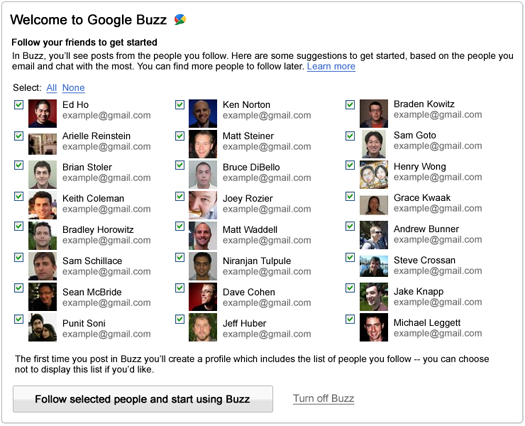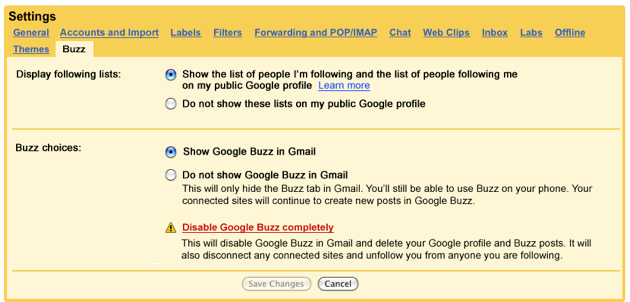 As we noted this morning, Google isn’t wasting any time in responding to user criticism about Buzz. Now they’ve rolled out another set of changes to further address Buzz’s privacy issues. The biggest change involves the automatic follow system: it’s now being switched to a suggestion model, where Google will present you with a list of friends it thinks you’d like to follow, but gives you a chance to deselect them before you start using the service.
As we noted this morning, Google isn’t wasting any time in responding to user criticism about Buzz. Now they’ve rolled out another set of changes to further address Buzz’s privacy issues. The biggest change involves the automatic follow system: it’s now being switched to a suggestion model, where Google will present you with a list of friends it thinks you’d like to follow, but gives you a chance to deselect them before you start using the service.
That’s a pretty big change — when Buzz launched four days ago, one of its selling points was that it took no work on the user’s part to get started, because Buzz would automatically follow the people you interact with most on Gmail. Of course, that isn’t always a good thing — there are plenty of cases when you wouldn’t want people to know who you’d been communicating with. After an initial backlash Google made it easier to hide which users you were following, but now they’re ditching the auto-follow model entirely. Fortunately it only takes a minute to go through the suggestions, so it’s not much of a hurdle.

New users will see a screen like the one above, and Google’s post says that existing Buzz users will be shown a version of this friend selection screen in the next few weeks to confirm that they’re comfortable with everyone they’re following. The service is also going to stop automatically connecting Google Reader and Picasa albums to Buzz accounts, though those options will still be available.
Finally, Google is adding a Buzz section to Gmail’s Settings. Why this wasn’t there from the start is beyond me — before now, if you wanted to adjust your Buzz settings you had to go to your Google account page, which made very little sense because most people use Buzz from Gmail.

Earlier today, Google made yet another change to Buzz’s privacy settings by fixing a bug that could cause users to inadvertently expose their friends’ private settings.
All of these are good changes for Buzz, and I’m optimistic about its future, but I can’t help but wonder how they all made it through months of internal testing.